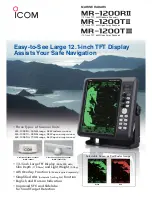
Power Supply Requirements
VHF Antenna Requirements
Nominal 13.8 VDC power supply with a negative ground (10.5 VDC to
16.0 VDC).
Power leads should be kept as short as possible. A direct connection to
the power supply is ideal.
Minimum of #14 AWG copper wire for extensions up to 20 feet, 12 AWG
wire for extensions from 20 to 35 feet, or 10 AWG wire for extensions
from 35 to 60 feet.
Male PL-259 connector
50 Ω impedance
Minimum 3 foot, 3 dB rated antenna for sailboats or 8 foot, 6 dB
rated antenna for powerboats
Minimum RG-58 lead-in wire for antenna leads up to 20 feet,
RG-8X for antenna leads from 20 to 35 feet, or RG-8U for antenna
leads from 35 to 60 feet.
1. Connect the BLACK wire of the power cable to the NEGATIVE (-) side of your power source.
2. Connect the RED wire of the power cable to the POSITIVE (+) side of your power source.
NOTE: To extend the life of the radio, use waterproof tape to seal electrical connections.
3. Install your antenna according to the manufacturer’s instructions.
4. If necessary, consult the FCC guidelines for antenna separation. See Antenna Selection and Installation on page 37 for more
details. (In summary, the FCC recommends that antennas up to 3 dB be installed a minimum of 3 feet from any occupied location;
antennas over 3 dB should be installed at least 6 feet away.)
5. Connect the PL-259 connector from the antenna lead-in wires to the SO238 connector labeled ANTENNA on the back of your radio.
6. Plug the power cable into the power cable pigtail on the back of your radio.
Connecting the Accessory Cable
Use the accessory cable to connect the radio to a GPS receiver, a GPS chartplotter, and an external speaker. The wiring diagram below
shows the connections for each accessory.
Yellow: NMEA_IN (+)
Red: External Speaker (+)
White: NMEA_OUT
(+)
Orange: N/A
Black: GND/External Speaker (-)
Brown: NMEA_OUT
(-)
Bare: Shield/GND
Green: NMEA_IN (-)
ACCESSORY
CABLE WIRES
CONNECTS TO...
NMEA Data Output (-) or GND from GPS receiver
NMEA Data Output (+) from GPS receiver
NMEA Data Input (+) on Chartplotter
Speaker (-)/GND
Speaker (+)
NMEA Data Input (-) on Chartplotter
Connecting to a GPS Receiver
If you connect the radio to a GPS receiver, the radio can automatically transmit your current position during an automated distress
call or during a normal DSC call.
Your radio supports a standard NMEA0183 input from a GPS receiver. Follow the steps below to connect your radio to your GPS
receiver:
VHF490 RADIO
1-800-BOATING
24
Содержание 18114496
Страница 1: ...VHF490 FIXED MOUNT MARINE RADIO MODEL 18114496 Owner s Manual...
Страница 4: ......
Страница 44: ...NOTES VHF490 RADIO 1 800 BOATING 40...
Страница 45: ...VHF490 RADIO 1 800 BOATING 41...
Страница 46: ...VHF490 RADIO 1 800 BOATING 42...
Страница 47: ...VHF490 RADIO 1 800 BOATING 43...
Страница 48: ...www westmarine com Printed in Vietnam U01UT655ZZA 0...
















































